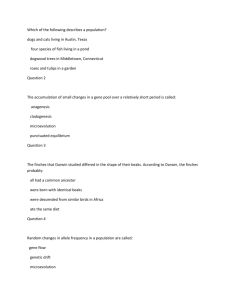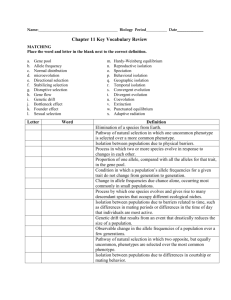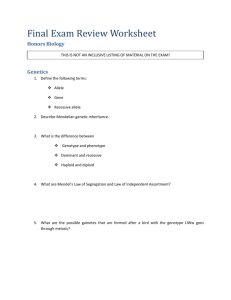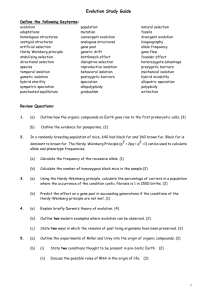Review WS
advertisement
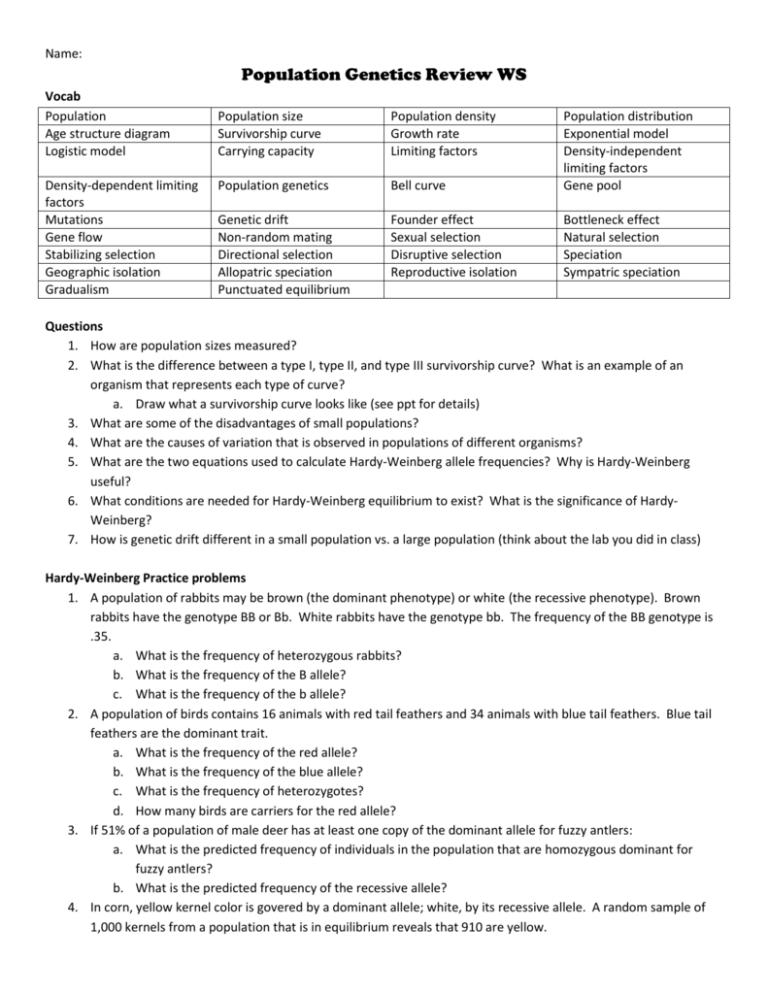
Name: Population Genetics Review WS Vocab Population Age structure diagram Logistic model Density-dependent limiting factors Mutations Gene flow Stabilizing selection Geographic isolation Gradualism Population size Survivorship curve Carrying capacity Population density Growth rate Limiting factors Population genetics Bell curve Population distribution Exponential model Density-independent limiting factors Gene pool Genetic drift Non-random mating Directional selection Allopatric speciation Punctuated equilibrium Founder effect Sexual selection Disruptive selection Reproductive isolation Bottleneck effect Natural selection Speciation Sympatric speciation Questions 1. How are population sizes measured? 2. What is the difference between a type I, type II, and type III survivorship curve? What is an example of an organism that represents each type of curve? a. Draw what a survivorship curve looks like (see ppt for details) 3. What are some of the disadvantages of small populations? 4. What are the causes of variation that is observed in populations of different organisms? 5. What are the two equations used to calculate Hardy-Weinberg allele frequencies? Why is Hardy-Weinberg useful? 6. What conditions are needed for Hardy-Weinberg equilibrium to exist? What is the significance of HardyWeinberg? 7. How is genetic drift different in a small population vs. a large population (think about the lab you did in class) Hardy-Weinberg Practice problems 1. A population of rabbits may be brown (the dominant phenotype) or white (the recessive phenotype). Brown rabbits have the genotype BB or Bb. White rabbits have the genotype bb. The frequency of the BB genotype is .35. a. What is the frequency of heterozygous rabbits? b. What is the frequency of the B allele? c. What is the frequency of the b allele? 2. A population of birds contains 16 animals with red tail feathers and 34 animals with blue tail feathers. Blue tail feathers are the dominant trait. a. What is the frequency of the red allele? b. What is the frequency of the blue allele? c. What is the frequency of heterozygotes? d. How many birds are carriers for the red allele? 3. If 51% of a population of male deer has at least one copy of the dominant allele for fuzzy antlers: a. What is the predicted frequency of individuals in the population that are homozygous dominant for fuzzy antlers? b. What is the predicted frequency of the recessive allele? 4. In corn, yellow kernel color is govered by a dominant allele; white, by its recessive allele. A random sample of 1,000 kernels from a population that is in equilibrium reveals that 910 are yellow. a. How many kernels are white? b. What are the frequencies of the yellow and white alleles in this population? c. How many kernels are heterozygous in this population? 5. A rare disease, which recessive and lethal when homozygous, occurs with a frequency of one in a million. a. How many individuals in a town of 14,000 can be expected to carry this allele? Diagrams Age Structure Look at the graphs below and answer the following questions 1. Identify in the age structure diagrams below which one represent the population exhibiting rapid growth, which one represents slow growth, and which one represents zero growth. Explain how you know this. Exponential vs. Logistical Growth Model Look at the graphs below and answer the following questions 1. 2. 3. 4. 5. Which type of population growth is shown in each of the graphs shown above? Which graph would most likely illustrate the growth of a deer population living in New Jersey? Which graph illustrates a population that has reached carrying capacity? Which graph illustrates the growth of a microbial population living in the most hospitable environment? Why don’t populations of organisms grow indefinitely? Types of Natural Selection Look at the pictures below and then answer the following questions 1. Identify which bell curve diagram is showing the original population, which one is showing directional selection, which is showing disruptive selection, and which is showing stabilizing selection. 2. Hypothesize what might influence each type of population to cause this type of natural selection. Speciation of California Salamanders 1. Identify in the picture to the right where geographic isolation plays a role in the speciation of the population of salamander. What type of speciation is demonstrated? 2. Identify in the picture to the right where reproductive isolation plays a role in the speciation of salamander. What type of speciation is demonstrated? 3. How does reproductive isolation prevent similar organisms from reproducing with each other? 4. What does speciation mean? 5. Observe the ancestral salamander, which is dark blue in color, and the western population, which get progressively lighter in blue color. If these species were formed from a single type of natural selection, which type is it most likely to be? Explain. 6. Competition for resources plays a key role in natural selection. Describe one way that competition might have influenced the evolution of salamander color.
